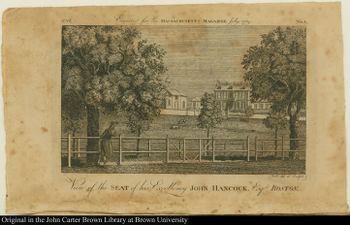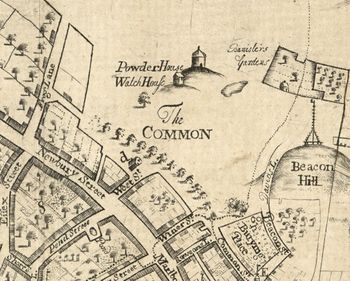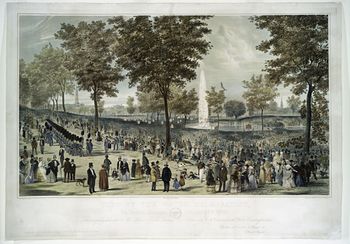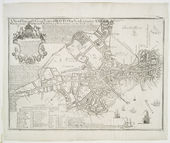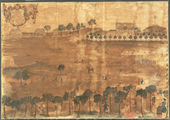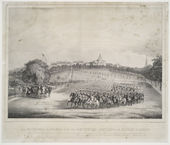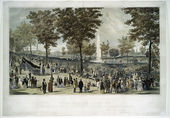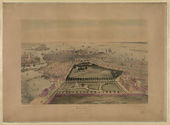Boston Common
Overview
Alternate Names: The Common; The Park; Training Field
Site Dates: 1634–present
Site Owner(s): City of Boston;
Location: Boston, MA · 42° 21' 18.32" N, 71° 4' 4.48" W
Condition: Extant
Other Resources: Getty TGN;
Boston Common is the oldest public park in the United States. Over time it has served as pastureland, burying ground, military encampment, theater for political action, and public ground, sometimes filling these various roles concurrently. Its history tracks the increasing levels of intervention in American landscape as its more utilitarian purposes ultimately yielded to its use for recreation and leisure.
History
Although the footprint of Boston Common has changed only marginally over its history, it has undergone numerous interventions that have transformed it from an open field into a landscaped park. Much of the nearly 50 acres that comprise the modern-day Common were purchased by the town from the Reverend William Blackstone in 1634 with the express purpose of preserving it as an open green space, held in common by the townspeople. Indeed, a 1640 decree by the Boston magistrates declared that “there shalbe noe land granted eyther for hous-plott or garden to any person out of the open ground or Comon Field.”[1] As a 1722 map of Boston reveals [Fig. 1], the Common was left almost entirely open and unaltered, with its featureless rolling hills providing an ideal place to pasture livestock. It was so popular for this purpose that the land quickly became overgrazed, and by 1646 the town was forced to place restrictions on the animals pastured there. Limited numbers of cattle and sheep continued to roam the Common, however, until the 1830s [Fig. 2].[2]
Beyond its use as pastureland, Boston Common fulfilled numerous judicial, religious, and military purposes from its inception. Public executions were apparently held on the grounds beginning in the 17th century, although the historical record is somewhat unclear. As one historian noted, we know that the Common boasted a gallows as early as 1656 due to an oblique reference in early town documents that “the gallows was [sic] ordered to be removed to the next knoll,” on March 31, 1656.[3] Even the histories of well-documented executions—such as those of the Quakers Marmaduke Stevenson, William Robinson, Mary Dyer, and William Leddra, who were hanged for heresy in 1659 and 1660[4]—are unspecific regarding location. While the Quaker executions have traditionally been sited on Boston Common, other sources indicate that the gallows were further south on Boston Neck. The lack of clarity on this point suggests that the number of executions on the Common remains unknown, even though they are believed to have been held there until 1812.[5] Better documented is the Common’s use as a burial ground, with a “burying place” (now the Granary Burying Ground) clearly marked on a 1722 map of Boston (see Fig. 1). Another interment site on the Common—the Central Burying Ground—was established by 1756.
The Common also served as a regular venue for preaching by both itinerant and local ministers. In the autumn of 1740, for instance, the celebrated evangelist George Whitefield traveled to Boston to raise money for the development of the Bethesda Orphan House—a newly-founded school for orphaned and poor girls, located in Chatham County, Georgia.[6] His sermon, delivered on the Common, proved enormously popular, and the Boston Weekly News-Letter announced Whitefield had collected more than £200 during his visit to the city. Celebrity was not, however, a precondition for preaching on Boston Common; in 1772, Massachusetts Spy described how an unnamed young man “mounted a stage in the Common” and soon drew an audience of “several thousands.”[7]
As the conspicuously marked Powder House and Watch House on early maps indicate [Fig. 3], the Common provided an important arena for military activity, and local militias often trained and mustered on the grounds. In 1684, for instance, it was described as “a training field; which ever since and now is used for that purpose.”[8] Its displays of martial readiness made the Common a popular venue for political action, such as the Sons of Liberty protest against the 1765 Stamp Act (see Paul Revere), as well as a deeply contested site during the occupation of Boston leading up to the Revolutionary War. As early as 1768 the British army regularly camped on the Common and, over the course of the conflict, constructed earthen fortifications for their encampment’s defense. Boston Common’s military associations remained well into the 19th century, with soldiers mustering on the grounds as late as the 1850s [Fig. 4].
In the late 18th and early 19th centuries, however, the various judicial, religious, and military roles of Boston Common were gradually overshadowed by its use as a recreational green space. Although it had always been used for leisure—in 1674, for instance, John Josselyn noted that it was a popular walking spot for “Gallants” and “their Marmalet-Madams”[9]—it was not until the 18th century that the Common underwent significant alterations to accommodate this function. A round of early improvements took place in 1728 and 1734 [see Fig. 4], when two rows of trees were planted on order of the Selectmen along Tremont Street which together formed a shaded walk known as the Mall—prior to this, the natural features of the Common were limited to a few scattered trees, including the “Great Elm” at its center, and a small spring-fed Frog Pond nearby, which functioned as a wading hole in summer and a skating pond in winter.[10] In 1784 additional trees were planted on the Common and parts of it leveled and graded. Under the direction of Josiah Quincy III, the second mayor of Boston, additional walkways were created and trees planted, so that the entire Common was enclosed by malls and crisscrossed with tree-lined paths by the 1830s [Fig. 5].[11] Some, such as George Jacques, took issue with the strict regularity of the paths and plantings, which, though “convenient and useful,” was incapable of pleasing the eye.[12]
Part of the ongoing landscaping efforts included alterations to Boston Common’s Frog Pond. Although originally a natural body of water, in 1826 its interior was paved, transforming it into a manmade basin.[13] It was later fitted with a fountain that, by 1848, was fed by a newly installed aqueduct that extended from Lake Cochituate in Natick, Massachusetts, to the Brookline Reservoir.[14] The aqueduct was a tremendous boon to the expanding city of Boston, and a celebration in Boston Common was organized to commemorate the event. “A great work has been effected,” the Boston Courier informed its readers, and “[e]very one among us will participate in the benefits thus secured to the dwellers in this busy and thriving metropolis.”[15] A long procession of citizens marched through the city’s streets to the Common and gathered at the Frog Pond, which had been fitted with an ornamented scaffolding on which sat the mayor, water commissioners, and other dignitaries [Fig. 6]. As the water began to flow into the basin, “[t]he fountain played in divers shapes, sometimes throwing a tall column of eighty feet into the air, and sometimes scattering a sheaf of jets to a wide extent around. The force and copiousness of the stream surpassed all expectation.”[15]
A colored lithograph by John Bachmann, c. 1850, reveals how dramatically Boston Common changed over time [Fig. 7]. No longer the open field shown in the 1722 map, Bachmann’s view, taken from the west, portrays the Common as a place of “public convenience and comfort,” in the words of his contemporary, Louisa C. Tuthill. “[F]resh young trees are planted from year to year by the side of the new-gravelled walks. . . and the little lake or pond near the centre, adds to its picturesque beauty.”[16] Moreover, it was no longer bordered on its western edge by water and mudflats, which had been filled, graded, and transformed into the Boston Public Garden by 1836. The history of Boston Common highlights the increasing degrees of intervention in early American landscape design, as the site’s more utilitarian purposes ultimately yielded to recreation and leisure.
—Elizabeth Athens
Texts
- Anonymous, 1640 and 1646, describing Boston Common, Boston, MA (quoted in Adams 1842: 7)[17]
- “[March 1660] Hereafter there shall be no land granted either for house plot or garden to any person, out of the open ground or common field, which is left between the Sentry Hill and Mr. Colburn’s end. . . .
- “[May 1646] No dry cattle, young cattle, or horse, shall be free to go on the Common this year but one horse of Elder Oliver.”
- Josselyn, John, 1674, describing Boston, MA (quoted in Reps 1965: 141)[18]
- “On the South there is a small but pleasant common, where the Gallants a little before Sunset walk with their Marmalet-Madams.”
- Anonymous, May 19, 1766, Boston Evening-Post (quoted in Brigham 1954: 21)[19]
- “ . . . [T]he Gentlemen Selectmen of Boston, have fix’d upon this Evening for the public Rejoicing, at whose Desire, will be exhibited on the Common, an OBELISK.—A Description of which is engraved by Mr. Paul Revere; and is now selling by Edes & Gill.—The Signal of its Ending will be by firing a Horizontal Wheel on the Top of the Obelisk, when its desired the Assembly would retire.”
- “On the south west side of the town, there is a pleasant promenade, called the Mall, adjoining to Boston Common, consisting of a long walk shaded by trees, about half the length of the Mall in St. James’s Park. At one end you have a fine view of the sea. The Common itself is a pleasant green field, with a gradual ascent from the sea shore, till it ends in Beacon Hill, a high point of land, commanding a very fine view of the country.”
- Anonymous, January 1, 1836, describing the Boston Common, Boston, MA (Horticultural Register 2: 33)[21]
- “Apart from the beautiful scenery connected with these resorts [public walks in New York], or in themselves alone, they cannot compare with our fine Common, of which Bostonians deservedly pride themselves, and which at a little expense might be made one of the most splendid places of promenade in the country.”
- Adams, Nehemiah, 1838, describing the picturesque quality of Boston Common, Boston, MA (Adams 1838: 40)[22]
- “Had its principles been regarded, we should have seen trees of various foliage, here standing alone, and there intermingled in copses and groves—arranged, indeed, so as to imitate nature herself, in her picturesqueness as well as her beauty.”
- Buckingham, James Silk, 1841, describing Boston Common, Boston, MA (1841: 2:331)[23]
- “This Common, as it is called, or ‘The Park,’ as it might with propriety be designated, with the fine view of the surrounding country from its more elevated parts, and the noble trees and gravel-walks throughout, is only inferior in size and beauty to Hyde Park, Regent’s Park, and the Green Park in London; and is greatly superior to any similar enclosure in New-York, Philadelphia, or Baltimore. It covers an area of seventy-five acres, and has upward of 600 trees planted in it. The whole is enclosed with an ornamental iron fence or railing, which cost 90,000 dollars, or nearly £20,000. Within it is a fine sheet of water, surrounded with elms, called ‘The Crescent Pond’; and very near the centre of the whole are the remains or traces of a fortification, thrown up by the British troops who were stationed here in 1775.
- “The Common is surrounded on three of its sides by noble rows or terraces of houses, like the parks in London; and as it was originally granted for the public use, and any farther encroachment upon it rendered impossible by a clause in the last charter of the city, it is of the utmost value to the inhabitants. It is not merely a beautifully ornamental appendage to their noble city, but is used as a place of healthful and innocent recreation for all classes, as a spot of constant exercise and promenade; and it is impossible to witness its advantages without regretting that every town in England is not provided with a similar extent of public grounds for the delight and enjoyment of its population.”
- Adams, Nehemiah, 1842, describing Boston Common, Boston, MA (Adams 1842: 9, 11–12, 22, 28, 35, 51)[24]
- “Many, very many, in a great city, seldom see the arch of heaven. Even those who walk or ride for pleasure are often struck with the effect of a full view of the sky when they are out of the city. One of the great advantages of the Common is the unobstructed sight of the heavens above it. . . .
- “Indeed it is seldom that a piece of ground is seen which, with no greater extent, is so diversified in surface and combines so much in itself that is picturesque, as the Common. There is hill and plain, meadow and upland, in it. It has sufficient irregularity to make a pleasing variety of surface without being rough; its elevations are well sloped towards the plain part of the enclosure; indeed it would be difficult for art to arrange the surface of the Common more agreeable for pleasing effect or use. . . .
- “The Common with its malls for hoops, and ball, and marbles, and wicker carriages, its Frog Pond for boats and skating, its hills for coasting, its new cut grass, its training days and military parades, and fireworks, the governor taking his chair at ‘artillery election,’ and all its varied entertainments, contributes as largely as any place can do to the formation of those youthful impressions which make childhood happy, and the remembrances of it pleasant. . . .
- “The Common with its varied surface is admirably fitted for military exhibitions. . . .
- “One of the most interesting exhibitions that ever took place on the Common was that of the Indians of the Sacs and Fox, the Sioux and Iowa tribes, who visited us in the fall of 1837. They held a war dance on the Common in the presence of seventy thousand spectators. . . .
- “The centre of the Common is obstructed by rows of young but thrifty and fast increasing trees. They were planted along the principal paths, for the benevolent purpose of affording shade to those who cross the Common. Their usefulness even in this respect is doubtful, and there is more than a doubt respecting their good influence upon the Common as a public ground. Our summers are so short, the air of the Common is generally so cool or in such good circulation, that the use of shaded walks through its centre is very small compared with the desirableness of having one large open place, as the Common has always been, in a crowded city. We do not need the whole Common as a mere parasol; its wide and free grounds and prospect are its chief beauty, and the shaded malls are sufficient as places of resort from the heat. . . . There will soon be an end to great public exhibitions on the Common, if the trees now in the centre should thrive.”
- Tuthill, Louisa C. (Louisa Caroline), 1848, describing Boston Common, Boston, MA (1848: 318)[25]
- “The Boston Common is the most spacious public pleasure-ground in the United States. Seventy-five acres were appropriated by the early ‘fathers of the town’ to this purpose, on the condition that it should ever remain devoted in this way to public convenience and comfort. The same venerable elms which shaded the patriots of the Revolution, still wave over the heads of their successors, and fresh young trees are planted from year to year by the side of the new-gravelled walks, rendered necessary by the rapidly increasing population of the city. The undulating ground of the Common gives it a pleasing diversity of hill and vale, and the little lake or pond near the centre, adds to its picturesque beauty.”
- Loudon, J. C. (John Claudius), 1850, describing Boston Common, Boston, MA (1850: 332–33)[26]
- “856. Public Gardens. . .
- “At Boston there are extensive public pleasure-grounds called the Common, consisting of seventy-five acres, in the very heart of the city. This piece of ground is well laid out, and contains many fine trees. The state-house, and the handsome houses of the city, surround it on three sides.”
- Jaques, George, February 1851, describing the planting of trees in Boston Common, Boston, MA (Magazine of Horticulture 17: 50–52)[27]
- “I propose, at present, to speak first of planting trees upon side-walks. In American cities, it is customary to construct streets with a wide carriageway in the middle, and a walk for pedestrians on either side. Trees are usually planted on the line between these foot-walks and the carriageway. . .
- “Take as an example Boston Common. Here we have, for the most part, a smooth grass surface, intersected by straight wide gravel-walks, and these lined on each side with trees placed along at equal distances from each other. But suppose no tree or walk were there, and a carte blanche were given to any one that he might arrange all things to his own fancy, what would you do, Mr. Editor? Would you plant straight rows of equidistant trees there? Probably not. For, although such an arrangement of fruit or shade trees may be in its place very convenient and useful, it can never please the eye which admires the picturesque beauty of trees growing in groups.”
Images
Christian Remick, A Prospective View of Part of the Commons, c. 1768.
Sydney L. Smith (engraver) from a watercolor drawing by Christian Remick (c. 1768), A Prospective View of part of the Commons, 1902.
Benjamin Franklin Smith Jr., View of the Water Celebration, on Boston Common October 25th 1848, 1849.
John Bachmann, Bird’s Eye View of Boston, c. 1850.
Other Resources
Boston Common (National Park Service)
Notes
- ↑ Quoted in M. A. D. Howe, Boston Common: Scenes from Four Centuries (Boston: The Atlantic Monthly Press, 1921), 7, view on Zotero. For a more recent overview of the site, see James H. Charleton, National Register of Historic Places Inventory, Nomination Form, November 1985, view on Zotero.
- ↑ Howe 1921, 42, view on Zotero.
- ↑ Nathaniel Shurtleff, A Topographical and Historical Description of Boston (Boston: Printed by request of the City Council, 1871), 348, view on Zotero.
- ↑ One of the first publications to describe their deaths was Edward Burrough’s A Declaration of the Sad and Great Persecution and Martyrdom of the People of God, called Quakers, in New-England, for the Worshipping of God (1661).
- ↑ Howe 1921, 8n1, view on Zotero. See also Shurtleff 1871, 352, view on Zotero.
- ↑ One of his Boston auditors, the 14-year-old Elizabeth Pitts, would travel south to live at the Bethesda Orphan House.
- ↑ Massachusetts Spy, June 25, 1772, quoted in Mary Farwell Ayer, Boston Common in Colonial and Provincial Days (Boston: Privately printed, 1903), 25, view on Zotero. See also Howe 1921, 35, view on Zotero.
- ↑ Quoted in Howe 1921, 3, view on Zotero.
- ↑ Quoted in John W. Reps, The Making of Urban America: A History of City Planning in the United States (Princeton, NJ: Princeton University Press, 1965), 141, view on Zotero.
- ↑ The “Great Elm” was believed to have predated European settlement in Boston and was cherished in the 19th century as a witness to the city’s early history. It was felled by a storm in February 1876. See Anne Beamish, “Venerable Relic: The Great Elm on Boston Common,” Arboricultural Journal 30, no. 3 (2017): 144–61, view on Zotero.
- ↑ Shurtleff 1871, 320–28, view on Zotero.
- ↑ George Jaques, “Trees in Cities,” Magazine of Horticulture, Botany, and All Useful Discoveries and Improvements in Rural Affairs 17, no. 2 (February 1851): 50–52, view on Zotero.
- ↑ Howe 1921, 42, view on Zotero.
- ↑ For a brief overview of the development of the aqueduct, see: http://www.newenglandhistoricalsociety.com/flashback-photo-boston-holds-a-water-celebration-in-1848/.
- ↑ 15.0 15.1 “The Water Celebration,” Boston Courier (October 26, 1848): 2, view on Zotero.
- ↑ Louisa C. Tuthill, History of Architecture, from the Earliest Times; Its Present Condition in Europe and the United States. . . (Philadelphia: Lindsay and Blakiston, 1848), 318, view on Zotero.
- ↑ Nehemiah Adams, Boston Common (Boston: William D. Ticknor and H. B. Williams, 1842), view on Zotero.
- ↑ John W. Reps, The Making of Urban America: A History of City Planning in the United States (Princeton, NJ: Princeton University Press, 1965), view on Zotero.
- ↑ Clarence Brigham, Paul Revere’s Engravings (Worcester, MA: American Antiquarian Society, 1954), view on Zotero.
- ↑ Henry Wansey, Henry Wansey and His American Journal, ed. David John Jeremy (1794; repr., Philadelphia: American Philosophical Society, 1970), view on Zotero.
- ↑ Anonymous, “Leaves from My Note Book,” Horticultural Register, and Gardener’s Magazine 2 (January 1, 1836): 29–33, view on Zotero.
- ↑ Nehemiah Adams, The Boston Common, or, Rural Walks in Cities (Boston: G. W. Light, 1838), view on Zotero.
- ↑ James Silk Buckingham, America, Historical, Statistic, and Descriptive, 2 vols. (New York: Harper, 1841), view on Zotero.
- ↑ Nehemiah Adams, Boston Common (Boston: William D. Ticknor and H. B. Williams, 1842), view on Zotero.
- ↑ Louisa C. Tuthill, History of Architecture, from the Earliest Times; Its Present Condition in Europe and the United States . . . (Philadelphia: Lindsay and Blakiston, 1848), 318, view on Zotero.
- ↑ J. C. Loudon, An Encyclopeaedia of Gardening; Comprising the Theory and Practice of Horticulture, Floriculture, and Arboriculture, and Landscape-Gardening, new ed. (London: Longman et al., 1850), view on Zotero.
- ↑ George Jaques, “Trees in Cities,” Magazine of Horticulture, Botany, and All Useful Discoveries and Improvements in Rural Affairs 17, no. 2 (February 1851): 50–52, view on Zotero.

